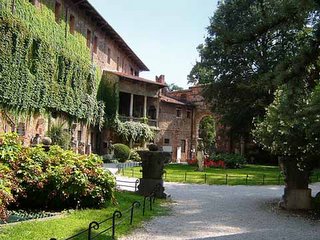
回想2002年六月的日本之旅,腦子裡閃過的還是京都府那座遺世獨立的山中小廟 – 美秀博物館(Miho Museum)。一座美術館為什麼會遺世獨立,我又為什麼稱它為山中小廟呢?就讓我娓娓道來。
Thinking of the trip to Japan in June 2002, the Miho Museum, what I called "a little temple isolated in the mountain" always came to my mind.
第一次聽到美秀博物館的大名,大概是幾年前無意間在某本藝術雜誌中讀到的,它之所以會如此引人注目,知名建築師貝聿銘先生大概是有力因素之一。頂著貝先生的光環,這座博物館在興建之初就吸引了高度的注意力,這幾年間,我也就一直引領企盼著,看看哪天真有機會一賭大師的作品。
I came across the info about this museum for the first time a few years ago, when reading a review of it in an art magazine. One of the reasons that it attracts lots of attention is for the fact that it was designed by the famous architect IM Pei. Upon its beginning it has been a highly discussed project, and I've been looking forward to going for a visit one day.
個人以為,在態度上而言,它並不是一座平易近人的博物館。為什麼這樣說呢?因為在位置的選擇上,就不是一個太容易到達的地點。坐火車至石山站下車以後,搭上前往博物館的公車,一路上顛顛倒倒,車子經過的地方越來越荒涼,周圍都是人煙罕見的田野山邊,經過大約一小時以後,我們一行人才抵達博物館。我為什麼會以「遺世獨立」這字眼形容它,不但是因為想要到館一遊的參觀者,真的必須要費一番功夫,如果不是有心人,大概也不會特地花上一整天到這裡朝聖吧!另一方面,貝先生在設計之初所採用的中心,是發自於中國荊、湘一帶「桃花源」這個民俗故事,與博物館所在地「桃谷」恰巧不謀而合,它與世隔絕,在這個紛亂的社會中,可謂清流一支,是人們沉澱心靈的安靜角落。
Attitude wise, it's not a very friendly museum. Why? For its location. It's not an easily accessible place. After getting off the train at the nearest train station, one has to take a bus ride for almost an hour, passing through countryside to arrive. It requires some efforts from visitor to go and if one wasn't intended to go he/she wouldn't spend a whole day for this pilgrimage. On the other hand, Pei's design was partly originated from the idea of the earthly paradise in the old Chinese tale, "Peach Blossom Spring." The valley where the museum is situated is called "Peach Valley". That's another coincidence. It takes people away from the chaotic society. A quiet place for those who long for an escape.
下了車,映入眼裡的是一座米白色建築物,是博物館接待來客的第一道關卡。我們一行人買了票,同行的母親與外公兩人,在館員的引導下,便搭上接待處與本館之間的交通車,而我,為了要經驗一下那種走進桃源的感受,便獨自踏上通往本館的路,慢慢步行至本館展示區。陶淵明在桃花源記中敘述的「忽逢桃花林,夾岸數百步,中無雜樹,芳草鮮美,落英繽紛」,桃花林在文中所代表的意涵,是由人間世界通往太平仙境的道路;我在這段路上並沒有看到真的桃花林,沿著走道兩旁,倒是重滿了櫻花樹,在貝先生的引導下,我來到一個通往美學殿堂的隧道,也許是心理作用所致,在穿過隧道、橫過天橋之時,心裡還真的有那種被淨化、被洗滌的感受,逐漸映入眼簾的,是一座融合廟宇特色的建築物。我拜訪博物館的當天並不是日本的假日,因此到館參觀的遊客並不多,在沒有旁人干擾的狀況下走過這一段路,周圍的蟲鳴鳥語也特別清楚,自然也就帶給我另一番新鮮感受。
Getting off the bus, a creamy white building came into y eyes. It's the "front door" of the museum. We got the tickets there. Under the guidance of the staff, my mom and grandpa went onto the shuttle which bring visitors back and forth the from entrance and the main building. To experience entering the "Peach Blossom Spring", I chose to walk. The story of Peach Blossom Spring was written by poet TaoYuan-Ming, and almost everyone of us read it at school. I remember the part describing the pathway into the Peach Blossom Spring, it represents the path from human world into heaven. I didn't really see peach trees but cherry blossoms. However, from Pei's guidance I did feel like walking into a temple of beauty. When I walked through the tunnel and bridge, I felt purified and cleansed. A peculiar building came into my eyes. Something that reminds me a Chinese temple. It's a pleasant week day, and there're not too many visitors. I was walking all alone and could clearly hear the birds singing. Quite a refreshing feeling.
穿過通往世界稀有珍寶的「夢之門」,我進入了以幾何圖形拼湊而成的正堂大廳。博物館內的展示廳分別依主題座落在南館與北館之中,展示以地域、文化宗教與年代等分別承現出秀明家族多年以來的精品收藏。所有展出物件之中,最讓我印象深刻的,大概就是那只宋代的耀變天目茶碗;根據館方所述,世界上被指定為國寶的耀變天目茶碗僅有三只,該館所收藏的,則是先前不為人知的第四只,茶碗上特殊罕見的結晶,是在燒製的過程中自然發生的,是中國福建省建窯所出產之陶器中的一種,該茶碗由前田利常開始在前田家流傳下來,碗的形態亦被記載於前田家茶道用具記錄中。
Going through "Dream Door", I arrived the main hall which brought to me a sense of geometry incorporated with nature. The exhibitions are divided into the North hall and South hall. The collections of the Shumei family are exhibited according to geographic area, culture, religion and chronology. One of the most impressive items is the yohen tenmoku teabowls from the Song Dynasty (China). According to the description of the museum, there're only three teabowl of this kind exist in this world, and the one in the museum is actually the forth which was unknown to the world before. The special crystals on the bowl was a rare thing to see. It was a kind produced in the Chinese Fujien province. It was passed down in the Maeda Family since Maeda Toshitsune and was also recorded in the utensil of tea ceremony of the family.
博物館配有極佳的展示語音導覽供參觀者租用,有中文、英文與日文三種可供選擇。語音系統中最可取之處,大概就是其資訊之深度採用分層之方式呈現,雖然館方選擇以CD播放的方式,在資訊點選後讀取的速度並不是很快,加上每位使用者都必須背著一台礙事的隨身聽,不過使用者可以自由地選擇想要瞭解的物件解說,加上在聽完解說以後,還可以選擇性地深入瞭解物件之文化背景,對於一個有心到館內慢慢參觀的觀眾來說,的確是極為方便的樂事。
The museum provides a good trilingual audio-guide service (Chinese, English and Japanese). Visitors can explore the info according to his needs and interest. Though the museum adopted CD player as media, the data reading was farely slow and it's quite a big thing to carry for the user, it is anyway a convenient device for those who intend to explore the museum in detail.
日本地區的博物館,最讓我驚豔的一點,通常是他們結合館藏、館徽與賣店商品的能力,精心設計的商品,往往讓人愛不釋手。本館也是如此,賣店裡除了販賣館內出版品以外,還有印上博物館館徽的日常用品以供購買,讓我最不捨擱下的,大概就是那套骨瓷茶具,白底金邊的設計,與博物館給我的感覺特別對味,若不是訂價高得嚇人,它大概已經躺在我家了吧!
One of the things I especially enjoy in Japanese museums is their museum shop. There're always a good selection of finely produced items or copies to be taken away as souvenir. I was attractly by the white bone china tea service set. If not for the high price, I would surely bring it back home.
受限於同行的母親與外公體力有限,加上回程公車時間上的限制,在館內徘徊三個小時以後,我們便踏上回程。在離館之前,我特地趕到館內的影片播放室,欣賞了一段有關貝先生設計建造本館的影片,再度讓我對於與事者對本館所耗費的心力與財力開了眼界。由於博物館之位址地處森林法保安林區域、砂防法指定區域與自然公園法縣立公園第三種特別地域,因此館方在建造時必須面對各種繁瑣的法令規章,加上貝先生在設計時特意將保護自然環境的概念引入,博物館建築物的80%被埋藏在地下,使博物館與周圍景色融為一體,建造時不但必須面臨愚公移山的難題,在硬體接近完成之際,還必須將地景恢復原狀,這種對於原始地景的尊重,是我從未想到的。透過巧奪天工的規劃與設計,美秀博物館和位於西班牙畢包爾(Bilbao)、由雕塑家Frank Gehry所設計的古根漢美術館一樣,都可說是極具特色的極品建築,不同的是,貝先生的創舉,讓美秀博物館在自然、藝術與建築物之間融洽調和的理念下誕生,對於以後的博物館建築師而言,不啻帶來另一種思考角度。
We were fairly tired after the visit and we also had to catch the bus. So we decided to leave after a three-hour visit. Before leaving, I went to the video room to see a short film documenting the whole project, and I was again surprised by how much efforts and money were put into this project. The museum is situated in a special protected area with triple kinds of limitation. So various laws and regulations have to be met. Also, Pei especially melted the idea of enviromental protection into his design and 80% of the building was actually buried underground so that the building can merge with the nature as much as possible. During construction, half a moutain was removed and then brought back when the building was about to be completed. A respect of the original landscape, it's something that I've never thought of before. Pei actually achieved a balance between nature and architecture and brought to the world another viewpoint.
博物館網址:www.miho.or.jp/chinese/index.htm






